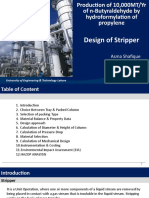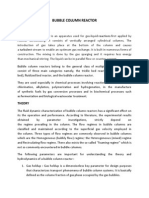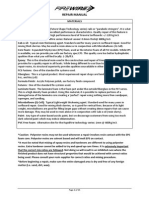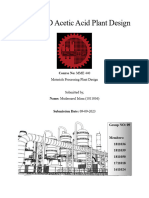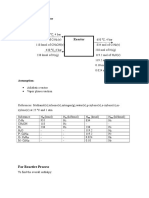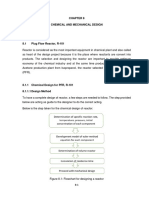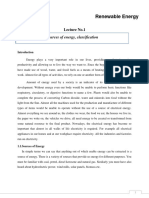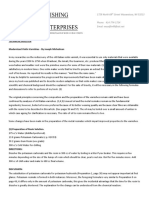Mechanical Design of Reactor
Uploaded by
DanialRemeMechanical Design of Reactor
Uploaded by
DanialReme1.
0 INTRODUCTION
Ethylbenzene is a single-ring alkylaromatic compound. It has a chemical formula of C6H5C2H3
and is liquid at room temperature. The production of ethyl benzene is vital due to the important
as the main raw material for several products. About 90% of Ethylbenzene production is used as
an intermediate in the production of styrene and the remaining 10 % is used as solvent for rubber
and paint manufacturing (Lee, 2006). Ethylbenzene can be found naturally in the crude oil but in
a small amount. Approximately crude oil contains only 2 % of ethyl benzene. Ethyl benzene can
easily evaporate to the air, it is also known as a flammable chemical.
In this plant Ethylbenzene production, reactor is like the heart for the whole plant as it’s
generates the main desired product. The Ethylbenzene process consist of reaction (involving
alkylation and trans-alkylation reactions) and separation section to separate benzene,
diethylbenzne, polyethylbenzene and trace impurities such as methane and ethane in distillation
column.
For trans-alkylation, it performed in reactor R2. For this simulation, adiabatic PFRs are
employed as they are used in liquid-phase trans-alkylation. Diethylbenzene is represented by 1-3
DiethylBenzene as it is most stable isomer and is present predominantly. Below are reactions
that occur in trans-alkylation and the mass balance calculations used excel spreadsheet:
Diethyl benzene + Benzene = 2 Ethyl benzene
Flow Rate:260.9 Flow Rate:260.9
kmol/hr kmol/hr
Temperature: 217.8 Temperature: 217.8
Pressure: 20 bar Pressure: 20 bar
B: 0.7471 R2 B: 0.7242
EB: 0.0005 EB: 0.2387
DEB: 0.2499 DEB: 0.0345
E: 0.0020 E: 0.0020
M: 0.0005 M: 0.0006
Figure 1.1: Block Diagram of Trans-alkylation Reactor
1
Equation of the reaction inside the Transalkylation Reactor:
𝐵𝑒𝑛𝑧𝑒𝑛𝑒 + 𝐷𝑖𝑒𝑡ℎ𝑦𝑙𝑏𝑒𝑛𝑧𝑒𝑛𝑒 → 2 𝐸𝑡𝑦𝑙𝑏𝑒𝑛𝑧𝑒𝑛𝑒
Table 1.2: Flowrate change according to the reaction
Stoichiometry -1 (reactant) -1(reactant) +2 (product)
Inlet 194.92 65.20
Efficiency 74.5
Outlet 146.35 16.63 97.4 – compare with
inlet reactant of
ethylbenzene ( 97.6)
Table 1.3: Excel Spreadsheet for transalkylation reactor calculation
Inlet Outlet
Component Mole Flow rate Component Mole Flow rate
Fraction (kmol/hr) fraction (kmol/hr)
Benzene 0.7471 194.91839 Benzene 0.7242 1021.8462
ethane 0.002 0.5218 Diethylbenze 0.0245 34.5695
ne
Ethylbenzene 0.0005 0.13045 Ethylbenzene 0.2387 336.8057
Diethylbenze 0.2499 65.19891 Ethane 0.002 2.822
ne
Methane 0.0005 0.13045 Methane 0.006 8.466
Total 1 260.9 Total 0.9954 1411
Ratio 0.184904323
This trans-alkylation use n isobaric process in which the pressure remains constant. The heat
transferred to the system does work, but also changes the internal energy of the system. PFRs are
chosen for trans-alkylation as they are industrially prevalent (Woodle). Based on journal, it show
that the reactor tend towards smaller reactor diameter, allowing greater radial mixing and
validating PFR assumption.
High benzene to Diethylbenzene ratio in trans-alkylation allows high Diethylbenzene conversion
to achieved at equilibrium, but at the cost of high recycle cost, whereas low ratio decrease
ethylbenzene selectivity with the formation of heavier by-product. The ratio of
2
Benzene/Diethylbenzene ratio should be between 2 and 4. Trans-alkylation reactor temperature
range of 170 to 270⁰C is allowed to maintain suitable catalytic activity and reasonable reaction
conversion, as well as ensure reaction is conducted in liquid phase.
In this production plant, the reactor of the trans-alkylation is like the main heart of the whole
plant because it is generating the main desired product. The catalyst used in this reactor is zeolite
in a solid phase, thus the most suitable reactor to use is A fluidized bed reactor is one in which
relatively small particles of catalyst are suspended by the upward motion of the reacting fluid.
The reaction is second order and elementary where it proves by looking the unit value of reaction
rate constant (k). This reactor is made up from Carbon Steel AISI 1030 to withstand hot working
and it is last longer and cheaply other than materials. In virtually all industrial applications the
fluid is a gas that flows upward through the solid particles at a rate that is sufficient to lift them
from a supporting grid, but which is not as large as to carry them out of the reactor or to prevent
them from falling back into the fluidized phase above its free surface. The particles are in
constant motion within a relatively confined region of space, and extensive mixing occurs in
both the radial and longitudinal directions of the bed.
Several advantages are associated with the use of fluidized bed reactors. A remarkably uniform
temperature can be maintained throughout the catalyst bed. This property is a consequence of the
high degree of turbulence within the bed, the high heat capacity of the solid catalyst comprising
the bed relative to the gas contained therein, and the extremely high interfacial area for heat
transfer between the solid and the gas phase. These factors facilitate control over the temperature
of the reactor and its contents. Better control in turn enhances the selectivity that can be achieved
and permits very large scale operations.
3
2.0 MECHANICAL DESIGN OF REACTOR
2.1 Introduction
In the design process of the mechanical part, there are aspects to be considered. The important
parameters need to be taken into measures is the flow rate, pressure, temperature and also the
corrosivity of the substance.
2.2 Volume of reactor
The volume of the reactor is calculated from the diameter and high generated from Aspen Hysys.
The diameter of the reactor is 1.88m and 12m respectively (Ng, Sharma, & Rangaiah, 2017). The
cylindrical column reactor is used instead of cubic form because of the higher internal pressure
which will deform the shape of cubic reactor. The formula for volume of cylinder is:
V= πr2h
Thus the volume of the reactor is 33.1m3.
2.3 Residence time
The space time of the reactor is calculated based on the liquid hourly space velocity, LHSV
which 2h-1 to 10h-1(SRI consulting, 1999). Then, the value of vo can be determined by applying
the formula:
𝑣𝑜 𝑙𝑖𝑞𝑢𝑖𝑑
LHSV=
𝑉
vo = LHSV * V
Then the value of space time can be deduced as:
𝑉
τ = 𝑣𝑜
So the value of the resident time is the same as space time because of the pressure and
temperature are constant(Scott, 2014).
4
Table 1: Excel Spreadsheet of residence time
LHSV (h-1) v0 Space time residence time
residence time (h)
(m3/h) (h) (min)
2 66.27 0.50 0.50 30
3 99.40 0.33 0.33 20
4 132.54 0.25 0.25 15
5 165.67 0.20 0.20 12
6 198.80 0.17 0.17 10
7 231.94 0.14 0.14 9
8 265.07 0.13 0.13 8
9 298.21 0.11 0.11 7
10 331.34 0.10 0.10 6
2.4 Wall thickness
In other to withstand high pressure and the corrosiveness in the reactor, the thickness of the wall
play an important part. A safety aspect must be consider by adjusting 10% overdsign of the
reactor pressure (Sinnott, 2005).
According to Sinnott, 2005 the minimum wall thickness required that sufficiently rigid to
withstand it on weight and any incidental load for 1 to 2 meter of vessel diameter is 7mm.
Figure 1: Chart for minimum thickness for a vessel
Since the diameter of the reactor is 1.9m, the minimum wall thickness must be more than 7mm.
The equation to determine the wall thickness of the reactor is
𝑃∗𝐷
𝑒=
2𝑓 − 𝑃
Where;
f is the design stress
P is the internal pressure
5
D is the diameter of the reactor
The design stress based on figure 2. The material used in constructing the reactor is carbon steel
and the operating temperature is 250°C. Thus, the value of f is 95 N/mm2.
Figure 2: Design stress of a metal according to the temperature
The thickness calculated for the reactor wall is 20 mm. Then, the value added with 2mm as a
corrosion allowance factor. The final thickness of the reactor wall is 22 mm. The value of the
calculated thickness is more than suggested value from figure 1. Thus, the value is acceptable.
2.5 Closure
The type of closure used to construct the plug flow reactor is a flat end closure with specification
of bolted cover. See figure 3 below:
Figure 3: Flat end closure with bolted cover
6
The flat end closure is very low cost but required a thick metal for a high pressure(Sinnott,
2005). To calculate the thickness of the flat end closure, equation below is used:
𝑃
e = CpDe√𝑓
Cp is taken as 0.55 for bolted end cover with narrow-face gasket as suggested in Coulson
Richardson book of engineering. The thickness for the closure is determined as 75 mm. The
value then adds with 2 mm for a corrosion allowance. Thus, the thickness of the closure is 77
mm.
7
3.0 MECHANICAL DRAWING
Figure 1: Mechanical Drawing
Figure 2: Front View
8
Figure 3: Side View
9
4.0 SPECIFICATION DATA SHEET
DATA SPECIFICATION SHEET
Identification: Reactor, R - 02 Date: 10th March 2018
No Required: 2
Function: To allow the reaction between diethyl benzene and benzene to produce
ethyl bezene
Operation: Continuous operation
Column Specification
Type of reactor Packed bed
Orientation Horizontal
Operation Continuous
Phase present Heterogeneous
Mode of operation Isothermal and isobaric
Design Pressure 200 atm (2000 kpa)
Volume of reactor 33.134m3
Operating Condition
Temperature 217.8⁰C
Pressure 200 atm
Space time
Total Inlet Flow 260 kmol/hr
Vessel Dimension and Specification
Inside diameter 1.88 m
Outside diameter 1.90 m
Height of vessel 12 m
Material of construction Carbon Steel (AISI 1030)
Wall thickness 20 mm + 2 mm corrosion allowance
Types of head and closure Flat end with bolted cover
Types of welded joint No welded joint
Heat transfer area
Overall heat transfer coefficient
Heat transfer apparatus Not available
Coolant fluid No coolant fluid
Catalyst used Zeolite catalyst
10
The designed reactor is a Trans-alkylation reactor with a identification of R-02. The
reactor allows the reaction between diethyl benzene with excess benzene to convert diethyl
benzene to benzene with the aid of zeolite catalyst. The reaction happens continuously in a
packed bed reactor with a heterogeneous phase, where the reactant is liquid and the catalyst is in
solid form. The reactor is operation in an isothermal and isobaric condition with a temperature of
217.8⁰C and pressure of 200 atm. The alkylation reactor has a volume of 33.134m3 and total inlet
flowrate of 260 kmol/hr. The internal diameter of 1.88m and external diameter of 1.90 m, while
the height of the reactor is 12 m. The wall thickness is 22 mm with the addition of the corrosion
allowance which is 2mm. The alkylation reactor is constructed using a carbon steel type AISI
1030.
11
5.0 COST OF CONSTRUCTION
Month Hot Hot Cold Hot Electr Wire Structu Reb Mercha
Roll Roll Rolle Dipped o-zinc Rod ral ar nt Bar
ed ed d Galvanis Coil (Mes Sections
Coil Plat Coil ed Coil h) and
e Beams
Jun - 507 528 581 674 737 492 594 481 545
2017
Stainless Steel Prices – US Dollar/Metric Ton
(Asian Carbon Steel Prices, 2018)
From the table above, hot rolled plate is used as the material and the price per tonnes is 528 Us
dollar. The total volume needed is 1.55 m3. The volume of the cylinder can be determined by
using the formula:
𝑐 = 2𝜋𝑟
The circumference formula is used to determine the length and:
𝐴 =ℎ×𝑙×𝑤
Where, the thickness is used as the wide.
For the weight of the carbon steel plates, it can be calculated using the formula of density which
is:
𝜌 = 𝑚/𝑉
Where,
ρ is the density if the carbon steel.
From the weight obtained, the total cost need to construct the reactor is 6424.44 US dollar.
12
You might also like
- Solution Manual Chemical Engineering Design 2nd Edition Towler13% (23)Solution Manual Chemical Engineering Design 2nd Edition Towler16 pages
- Design of Tubular Reactor in The Production of MonochlorobenzeneNo ratings yetDesign of Tubular Reactor in The Production of Monochlorobenzene2 pages
- Design of Packed Bed Reactor Catalyst Based On Shape Size PDFNo ratings yetDesign of Packed Bed Reactor Catalyst Based On Shape Size PDF14 pages
- Aspen Plus® Simulation Software - A Basic Course For Beginners - Unit 4 - Week 2 - Basic Process Modelling - Simulation OverviewNo ratings yetAspen Plus® Simulation Software - A Basic Course For Beginners - Unit 4 - Week 2 - Basic Process Modelling - Simulation Overview3 pages
- Transport Phenomena 2nd Edition (0471999903)63% (8)Transport Phenomena 2nd Edition (0471999903)303 pages
- Ch.E-403 Chemical Engineering Plant Design100% (1)Ch.E-403 Chemical Engineering Plant Design262 pages
- An Insight Into Chemical Engineering by M. Subbu100% (1)An Insight Into Chemical Engineering by M. Subbu198 pages
- Process Equipment Design Chapter 4 - Pressure Vessel Part 2No ratings yetProcess Equipment Design Chapter 4 - Pressure Vessel Part 284 pages
- Design of Distillation Column Control Systems100% (3)Design of Distillation Column Control Systems540 pages
- IV B. TECH (Chemical Engineering) I SemesterNo ratings yetIV B. TECH (Chemical Engineering) I Semester14 pages
- Bioreactor Design and Scale Up of Bioprocess Systems Part 2100% (1)Bioreactor Design and Scale Up of Bioprocess Systems Part 235 pages
- CRE-II - Chapter-04 Fluid-Particle Systems - HKB 2.10.18No ratings yetCRE-II - Chapter-04 Fluid-Particle Systems - HKB 2.10.1842 pages
- (Group 2) Plant Design Assignment 1 Task 2100% (2)(Group 2) Plant Design Assignment 1 Task 239 pages
- Ethylene Plus Benzene Design Project Reference (Partial Only)No ratings yetEthylene Plus Benzene Design Project Reference (Partial Only)11 pages
- Separations and Reaction Engineering Design Project Styrene ProductionNo ratings yetSeparations and Reaction Engineering Design Project Styrene Production10 pages
- Mineral Exploration in The Vicinity of The Late Ediacaran Bouteglimtaplite and Pegmatite Dikes Inimiter Inlier Using Aster Data: Preliminary ResultsNo ratings yetMineral Exploration in The Vicinity of The Late Ediacaran Bouteglimtaplite and Pegmatite Dikes Inimiter Inlier Using Aster Data: Preliminary Results21 pages
- 20 Day Checklist - April Attempt 2023 PDFNo ratings yet20 Day Checklist - April Attempt 2023 PDF1 page
- Nonlinear Finite Element Analysis of FRP Strengthened Full SizeNo ratings yetNonlinear Finite Element Analysis of FRP Strengthened Full Size25 pages
- Contents:: Properties of Hot and Cold Drawing Process Advantages & Disadvantages BibliographyNo ratings yetContents:: Properties of Hot and Cold Drawing Process Advantages & Disadvantages Bibliography7 pages
- Inter 1 Chemistry Success Series 2019 by Ambitious PDF100% (2)Inter 1 Chemistry Success Series 2019 by Ambitious PDF17 pages
- Process and Product Audit Plan For Cup-Cone For The Year of 2018No ratings yetProcess and Product Audit Plan For Cup-Cone For The Year of 201811 pages
- How To Make Weld Map, Shop Weld Plan, WPS, PQR & WPQ For A Static Pressure Vessel (Part-2)No ratings yetHow To Make Weld Map, Shop Weld Plan, WPS, PQR & WPQ For A Static Pressure Vessel (Part-2)19 pages
- Tasnee LD 4025as Polyethylene: DescriptionNo ratings yetTasnee LD 4025as Polyethylene: Description2 pages
- An ISO /TS 1694:2009 Certified Company: Material DataNo ratings yetAn ISO /TS 1694:2009 Certified Company: Material Data3 pages





